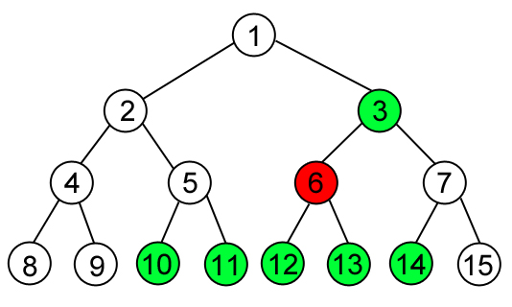题意是这样:
一颗高为h的完美二叉树,根节点为1,标号为i的结点的左右儿子标号分别为2*i,2*i+1
q次操作,i,l,r,ans
ans==0时,代表在第i层,出口的祖先不在[l,r]之间
ans==1时,代表在第i层,出口的祖先在[l,r]之间
若出口(出口一定在叶子上)唯一则输出它的标号,不唯一或无解则分别输出对应的串
我想到的做法很显然,把所有ans==1的子树的叶子区间全部算出来,遍历所有区间,
不断做交集,若不出现交集则无解,于是结果必然是得到一个唯一区间x,出口一定在这里面。
把所有ans==0的子树的叶子区间全部算出来,遍历所有区间,x不断删除与他们相交的部分,
很显然若是最终x的区间只有一个数,那么出口唯一就是这个数,否则有多个解
想到这个很简单。。编码有点麻烦……不过慢慢分治还是能够写对的
#include<map>
#include<string>
#include<cstring>
#include<cstdio>
#include<cstdlib>
#include<cmath>
#include<queue>
#include<vector>
#include<iostream>
#include<algorithm>
#include<bitset>
#include<climits>
#include<list>
#include<iomanip>
#include<stack>
#include<set>
using namespace std;
typedef long long ll;
struct Itv
{
ll l,r;
Itv(){}
Itv(ll l,ll r)
{
this->l=l;
this->r=r;
}
Itv its(Itv one)
{
if(one.r<l||one.l>r)
return Itv(1,0);
return Itv(max(one.l,l),min(one.r,r));
}
};
ll fac[60]={1};
Itv cg(ll val,int lv,int h)
{
return Itv(fac[h-lv]*val,fac[h-lv]*val+fac[h-lv]-1);
}
bool cmp(Itv one,Itv two)
{
return one.l<two.l;
}
int main()
{
int h,q;
cin>>h>>q;
for(int i=1;i<=h;i++)
fac[i]=fac[i-1]*2;
vector<Itv>itv[2];
while(q--)
{
int i,ans;
ll l,r;
cin>>i>>l>>r>>ans;
itv[ans].push_back(Itv(cg(l,i,h).l,cg(r,i,h).r));
}
int n=itv[0].size(),m=itv[1].size();
for(int i=1;i<m;i++)
{
itv[1][0]=itv[1][0].its(itv[1][i]);
if(itv[1][0].l>itv[1][0].r)
{
puts("Game cheated!");
return 0;
}
}
Itv t;
if(m!=0)
t=itv[1][0];
else
t=Itv(cg(1,1,h).l,cg(1,1,h).r);
sort(itv[0].begin(),itv[0].end(),cmp);
ll ans=-1;
for(int i=0;i<n;i++)
{
Itv t1=t.its(itv[0][i]);
if(t1.l>t1.r)
continue;
if(t1.l==t.l&&t1.r==t.r)
{
if(ans==-1)
puts("Game cheated!");
else
cout<<ans;
return 0;
}
if(t1.l-t.l>1)
{
puts("Data not sufficient!");
return 0;
}
if(t1.l-t.l==1)
{
if(ans==-1)
{
ans=t.l;
if(t.r==t1.r)
{
cout<<ans;
return 0;
}
}
else
{
puts("Data not sufficient!");
return 0;
}
}
t.l=t1.r+1;
}
if(ans==-1)
{
if(t.l==t.r)
cout<<t.l;
else
puts("Data not sufficient!");
}
else
puts("Data not sufficient!");
}
Amr bought a new video game "Guess Your Way Out! II". The goal of the game is to find an exit from the maze that looks like a perfect binary tree of height h. The player is initially standing at the root of the tree and the exit from the tree is located at some leaf node.
Let's index all the nodes of the tree such that
- The root is number 1
- Each internal node i (i ≤ 2h - 1 - 1) will have a left child with index = 2i and a right child with index = 2i + 1
The level of a node is defined as 1 for a root, or 1 + level of parent of the node otherwise. The vertices of the level h are called leaves. The exit to the maze is located at some leaf node n, the player doesn't know where the exit is so he has to guess his way out!
In the new version of the game the player is allowed to ask questions on the format "Does the ancestor(exit, i) node number belong to the range [L, R]?". Here ancestor(v, i) is the ancestor of a node v that located in the level i. The game will answer with "Yes" or "No" only. The game is designed such that it doesn't always answer correctly, and sometimes it cheats to confuse the player!.
Amr asked a lot of questions and got confused by all these answers, so he asked you to help him. Given the questions and its answers, can you identify whether the game is telling contradictory information or not? If the information is not contradictory and the exit node can be determined uniquely, output its number. If the information is not contradictory, but the exit node isn't defined uniquely, output that the number of questions is not sufficient. Otherwise output that the information is contradictory.
The first line contains two integers h, q (1 ≤ h ≤ 50, 0 ≤ q ≤ 105), the height of the tree and the number of questions respectively.
The next q lines will contain four integers each i, L, R, ans (1 ≤ i ≤ h, 2i - 1 ≤ L ≤ R ≤ 2i - 1,  ), representing a question as described in the statement with its answer (ans = 1 if the answer is "Yes" and ans = 0 if the answer is "No").
), representing a question as described in the statement with its answer (ans = 1 if the answer is "Yes" and ans = 0 if the answer is "No").
If the information provided by the game is contradictory output "Game cheated!" without the quotes.
Else if you can uniquely identify the exit to the maze output its index.
Otherwise output "Data not sufficient!" without the quotes.
3 1 3 4 6 0
7
4 3 4 10 14 1 3 6 6 0 2 3 3 1
14
4 2 3 4 6 1 4 12 15 1
Data not sufficient!
4 2 3 4 5 1 2 3 3 1
Game cheated!
Node u is an ancestor of node v if and only if
- u is the same node as v,
- u is the parent of node v,
- or u is an ancestor of the parent of node v.
In the first sample test there are 4 leaf nodes 4, 5, 6, 7. The first question says that the node isn't in the range [4, 6] so the exit is node number 7.
In the second sample test there are 8 leaf nodes. After the first question the exit is in the range [10, 14]. After the second and the third questions only node number 14 is correct. Check the picture below to fully understand.






















 702
702











 被折叠的 条评论
为什么被折叠?
被折叠的 条评论
为什么被折叠?








